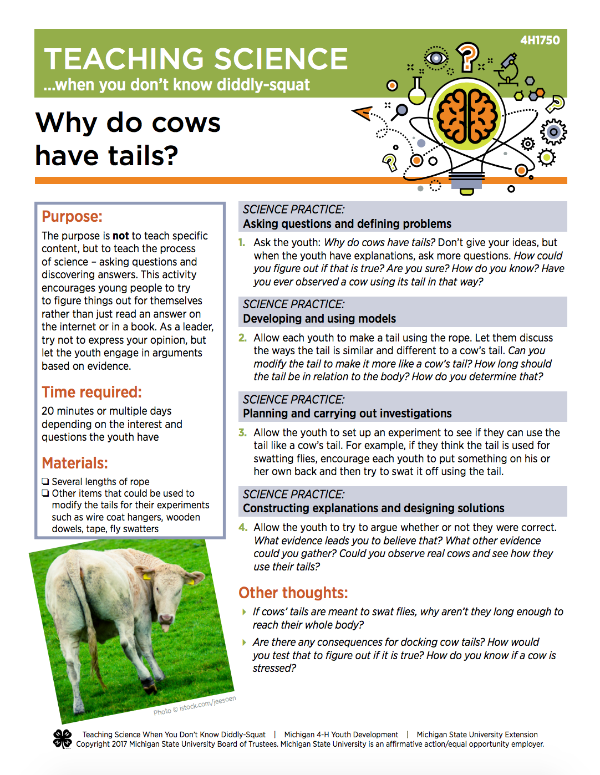
Bulletin 4H1750
Teaching science when you don’t know diddly-squat: Why do cows have tails?
DOWNLOAD
March 6, 2017 - Michigan State University Extension
Purpose:
The purpose is not to teach specific content, but to teach the process of science – asking questions and discovering answers. This activity encourages young people to try to figure things out for themselves rather than just read an answer on the internet or in a book. As a leader, try not to express your opinion, but let the youth engage in arguments based on evidence.
Time required:
20 minutes or multiple days depending on the interest and questions the youth have
Materials:
- Several lengths of rope
- Other items that could be used to modify the tails for their experiments such as wire coat hangers, wooden dowels, tape, fly swatters
Science Practice:
Asking questions and defining problems
1. Ask the youth: Why do cows have tails? Don’t give your ideas, but when the youth have explanations, ask more questions. How could you figure out if that is true? Are you sure? How do you know? Have you ever observed a cow using its tail in that way?
Science Practice:
Developing and using models
2. Allow each youth to make a tail using the rope. Let them discuss the ways the tail is similar and different to a cow’s tail. Can you modify the tail to make it more like a cow’s tail? How long should the tail be in relation to the body? How do you determine that?
Science Practice:
Planning and carrying out investigations
3. Allow the youth to set up an experiment to see if they can use the tail like a cow’s tail. For example, if they think the tail is used for swatting flies, encourage each youth to put something on his or her own back and then try to swat it off using the tail.
Science Practice:
Constructing explanations and designing solutions
4. Allow the youth to try to argue whether or not they were correct. What evidence leads you to believe that? What other evidence could you gather? Could you observe real cows and see how they use their tails?
Other thoughts:
- If cows’ tails are meant to swat flies, why aren’t they long enough to reach their whole body?
- Are there any consequences for docking cow tails? How would you test that to figure out if it is true? How do you know if a cow is stressed?
Science & Engineering Practices:
- Asking questions and defining problems
- Developing and using models
- Planning and carrying out investigations
- Analyzing and interpreting data
- Using mathematics and computational thinking
- Constructing explanations and designing solutions
- Engaging in argument from evidence
- Obtaining, evaluating, and communicating information
Reference:
National Research Council. (2012). A framework for K-12 science education: Practices, crosscutting concepts, and core ideas. Washington, DC: National Academies Press.



 Print
Print Email
Email




